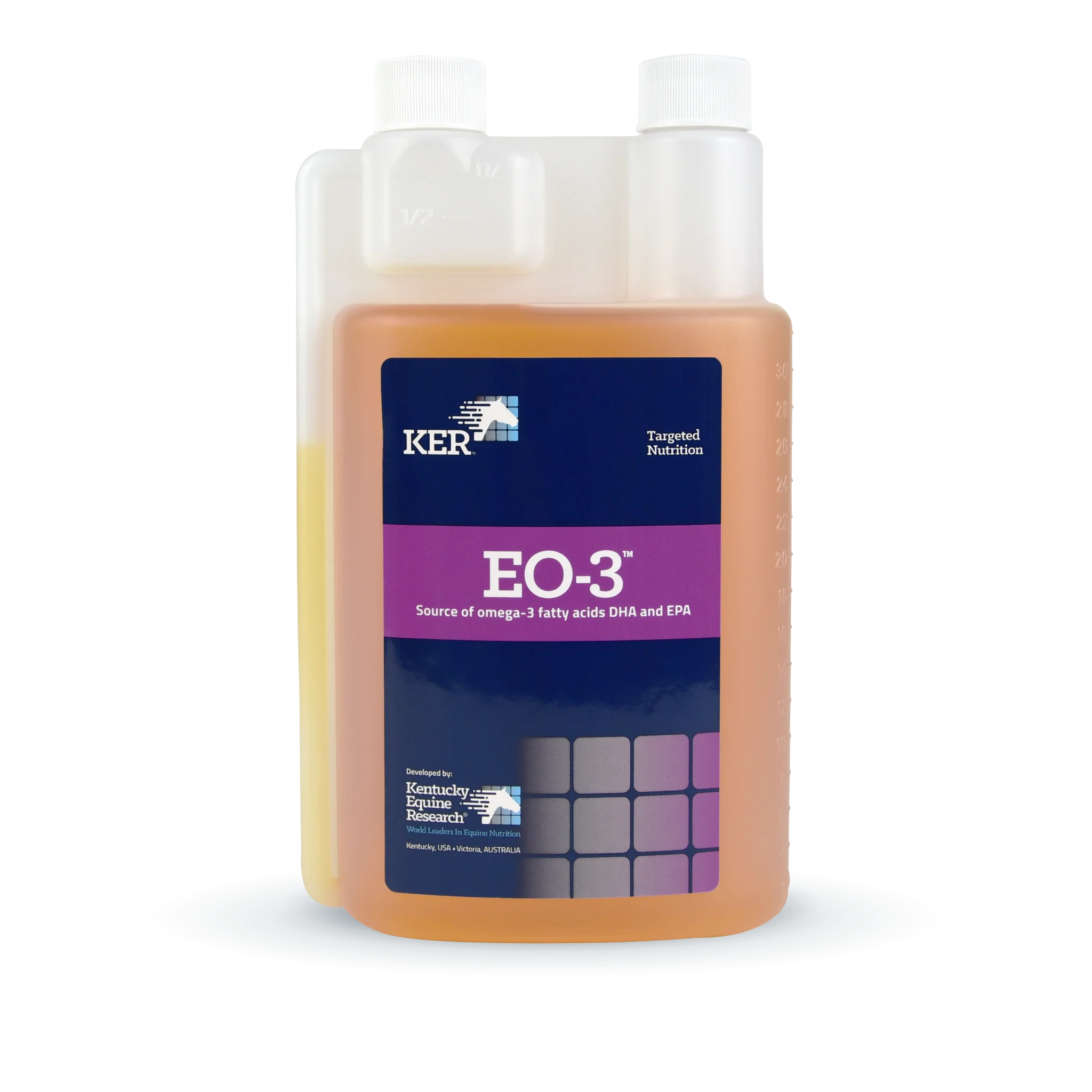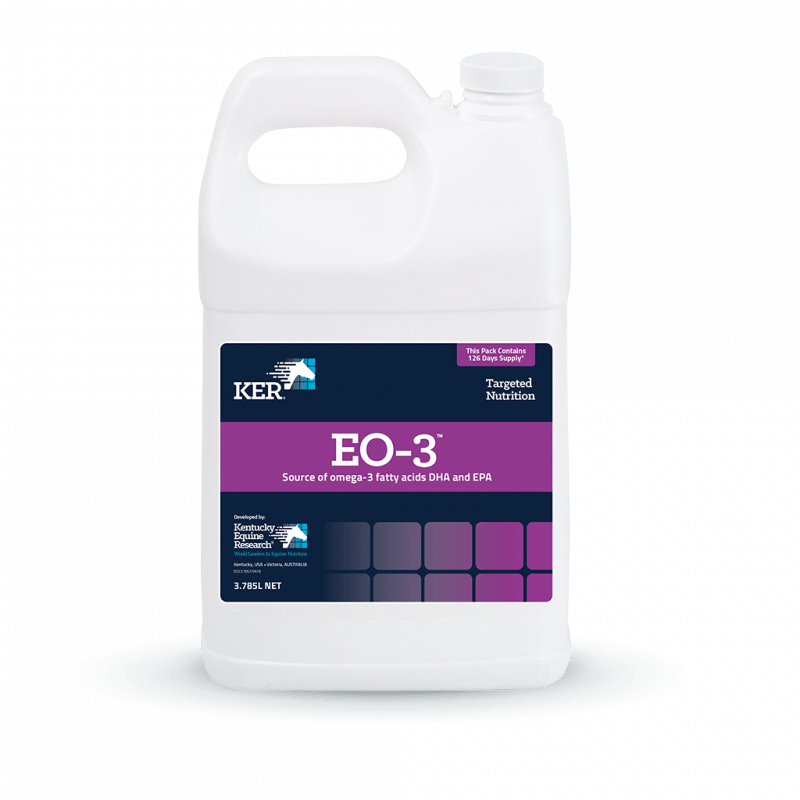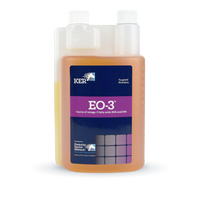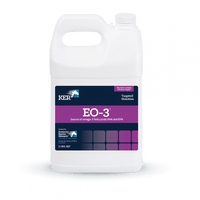Ker EO3
- Regular Price
- $165.95
- Sale Price
- $165.95
- Regular Price
- Unit Price
- per
Concentrated Direct Source Of DHA And EPA Omega 3-Fatty Acids
Now with minty apple flavour - four times as palatable

New size - Self measuring 946ml bottle - Convenient trial and travel pack now available.
EO-3 is a rich source of the long-chain omega-3 fatty acids DHA and EPA in a palatable liquid form.
EO-3 can be fed to all classes of horses including foals, breeding stock, and performance horses to improve the critical ratio of omega-3 to omega-6 fatty acids in the diet.
EO-3 provides preferential precursors for production of anti-inflammatory local hormones and regulates gene expression to positively affect insulin sensitivity.
New minty apple EO-3 is four times as palatable as the original. Along with a research-proven flavour update, a more highly refined base oil eliminates compounds that can increase fish odors over time, without altering beneficial fatty acids. Read the research behind this product update.

Why use EO-3?
- Ratio of omega-3 to omega-6 is 12:1
- Benefits of DHA- and EPA-mediated inflammatory response include reduction in joint inflammation, allergic reactivity, Equine Asthma (IAD, RAO)
- Improves glucose tolerance
- Strengthens immune function
- Increases red blood cell flexibility, which reduces the risk of exercise induced pulmonary haemorrhage (EIPH)
- Reproductive benefits include improved fertility and colostrum quality, enhanced passive transfer of antibodies to foals, and increased sperm concentration, motility, and viability
- Highly refined fish oil with minty apple flavour for 4x improved palatability
When to use EO-3
- Horses in intense work
- Horses with EIPH (bleeders)
- Horses on high-grain diets, or omega-6 skewed diets
- Horses with joint inflammation
- Horses with allergies and skin conditions
- Horses with metabolic syndrome
- Horses with fertility concerns, including stallions and mares around breeding time and for lactating mares and mares in late pregnancy
Not all Omega 3 Sources are Equal!
EO-3 contains more long-chain omega 3 fatty acids (EPA and DHA) compared to other omega 3 supplements.

Plant-based supplements contain omega 3 fatty acids in the short-chain form and the conversion in horses to the long-chained form of EPA and DHA is not very efficient.
EO-3 has a total omega 3:6 ratio of 12:1, compared to a linseed which is 3:1 and canola oil which is 1:1.5. Adding just 30ml of EO-3 will provide more benefits associated with omega 3 supplementation than a plant-based supplement.
Nutritional Content |
per 30mL |
% |
| EPA and DHA | 6,750mg | 25% |
| Omega-3 fatty acids | 9,450mg | 35% |
| Omega-6 fatty acids | 810mg | 3% |
| Fat | 29.4g | 98% |
Feeding Recommendations
Add 1 to 2 oz (30 to 60 mL) to the feed.
For best results, introduce EO-3 to the ration gradually over a period of 5 to 10 days.
Available Pack Sizes
| 3.785 L | 126 day supply* |
| 18.93 L | 631 day supply* |
| 946ml | 32 day supply* |
*based on a 30mL serving
Horses are often fed diets composed entirely of grain mixes and hay. Such diets are rich in omega-6 fatty acids but extremely low in omega-3 fatty acids. If vegetable oil is added to the ration, it further skews the ratio, with omega-6 fatty acids being overrepresented. To help counteract this imbalance, horses should be supplemented with omega-3 fatty acids, the richest sources of which are fish oils.
Kentucky Equine Research developed EO-3™, a potent marine-derived oil that is rich in omega-3 fatty acids. EO-3 is a palatable oil that is top-dressed onto the feed. EO-3 contains the omega-3 fatty acids DHA and EPA. KER has shown EO-3 to be highly palatable when compared to other marine-derived oils.
EO-3 is intended to be fed to horses of all classes and working levels to improve the critical omega-3:omega-6 ratio in their diets.
The equine athlete that is provided EO-3 can benefit from the difference in inflammatory response. In addition, EO-3 has also demonstrated benefits to the cardiovascular system, reproductive performance, and bone development in numerous research studies in a variety of animal species. The consumption of EPA and DHA from a source such as EO-3 is the only way to ensure that these fatty acids are available for metabolism of the “less-inflammatory” compounds and other metabolites beneficial for the horse’s overall health and well-being.
EO-3 supplies omega-3 fatty acids, compounds with positive effects on reproduction, bone development and numerous inflammatory conditions in horses.
Omega-3 Fatty Acids
Significant members of the omega-3 family are EPA, DHA, and ALA. EPA and DHA are found almost exclusively in fish, namely cold-water species, since they are at the top of a food chain based largely on algae that manufacture EPA and DHA. On the other hand, ALA is found predominantly in leafy plants and flaxseed (linseed).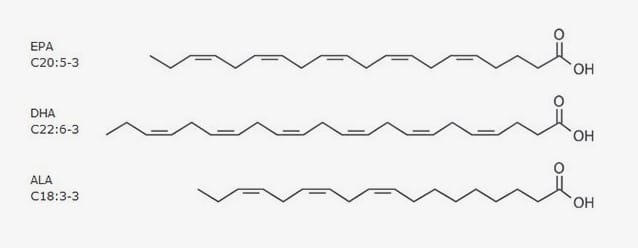
Omega-6 Fatty Acids
The primary source of omega-6 fatty acids in the diet is LA derived from the oils of seeds and grains. Corn, sunflower, and safflower oil contain abundant quantities of LA. Arachidonic acid (AA) is an intermediate in the metabolism of LA to the various cytokines termed “pro-inflammatory.”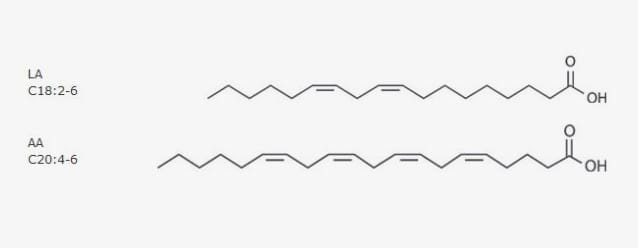
The Omega-3 to Omega-6 Ratio: A Balancing Act
Omega-3 and omega-6 fatty acids must be balanced within the body in order for both to be effective. The significant biological difference between omega- 3 fatty acids and omega-6 fatty acids is related to their roles as precursors of inflammatory and immune intermediaries. For example, each fatty acid is necessary for the production and distribution of prostaglandins. The prostaglandins that evolve from consumption of omega-3 and omega-6 fatty acids have different effects on inflammation processes in the body.The omega-3 fatty acids, EPA and DHA, are precursors of a class of inflammatory compounds that yield a milder response than those produced from omega- 6 fatty acids. In other words, the inflammatory response from cytokines and prostaglandins that originate from these omega-3 fatty acids is moderate compared to the response from cytokines and prostaglandins derived from omega-6, which are considered “pro-inflammatory”by comparison.Scientists have not pinpointed the optimal ratio of omega-3 fatty acids to omega-6 fatty acids for horses of various ages and uses, though they believe a ratio of 2 to 4:1 may be optimal. Even without an exact ratio, general knowledge of omega-3 and omega-6 fatty acids and typical equine management practices uncover some undesirable trends.Feedstuffs have varying levels of omega-3 and omega-6 fatty acids. The natural diet of horses—primarily fresh and dried forages—contains more omega- 3 fatty acids than diets consisting of a mixture of forage and cereal grains. Domesticated horses are frequently given concentrated sources of energy in the form of grain meals. Grains possess more omega-6 fatty acids than forage. Performance horses are often fed supplemental sources of fat to add much needed calories to their rations. Corn oil, probably the most popular fat supplement offered to horses, as well as safflower oil, canola oil, and sunflower oil, is rich in omega-6 fatty acids. Feeding one or more of these, especially in combination with a high-grain diet, may supply a horse with a surplus of omega-6 fatty acids, skewing the ratio of omega-3 to omega-6 fatty acids and creating a balance of omega-3 to omega-6 fatty acids that may be inappropriate. Such diets may not be as beneficial as one abundant in omega-3 fatty acids.EO•3 – Preferential Source for Omega-3 Fatty Acid Supplementation
Plant sources of omega-3 fatty acids such as flaxseed (linseed) are inferior sources due to inherent metabolic disadvantages. Even though EPA and DHA (20 and 22 carbon, respectively) can be formed in vivo by elongation of alpha-linolenic acid (ALA) (18 carbon), this process is inefficient and complicated. In addition, the enzymes used in the metabolism of ALA to EPA and DHA are the same enzymes used to elongate LA to AA. When horses consume feeds with greater quantities of LA (omega-6) than ALA (omega-3), the concomitant conversion of LA (18 carbon-omega-6) to AA (20 carbon–omega-6) results in the production of more pro-inflammatory cytokines and prostaglandins.Only fish oils are direct sources of EPA and DHA. In the past, these oils were typically not as palatable as those that provide more generous quantities of omega-6 fatty acids. However, recent studies at Kentucky Equine Research (KER) have shown that advances in processing technology have overcome the palatability issue inherent in the use of fish oil.Polyunsaturated Fatty Acid Composition of Commonly Used Oils| Oil Type | Omega-3 Concentration | Omega-3:Omega-6 | Predominant Omega-3 Source |
|---|---|---|---|
| EO•3 | 35% | 12 | EPA and DHA |
| Flax oil | 54% | 4.15 | ALA |
| Soy oil | 7% | 0.14 | ALA |
| Rice bran oil | 1% | 0.03 | ALA |
| Corn oil | 1% | 0.02 | ALA |
Feeding Directions
Add 1 to 2 oz (30 to 60 mL) to the feed. For best results, introduce EO-3 to the ration gradually over a period of 5 to 10 days.In racehorses, we recommend stopping this product 24 hours prior to racing. Why?| Guaranteed Analysis | Concentration | Per 30 mL |
|---|---|---|
| Fat | 98% | 29.4 g |
| Omega-3 fatty acids | 35% | 9,450 mg |
| DHA and EPA | 25% | 6,750 mg |
| Omega-6 fatty acids | 3% | 810 mg |
